Medieval Baltic


The Viking Age
- A sewing basket
- Skjoldehamn hood and tunic
- Garðar and Heynes mittens
- Mitten article translation
- Triangular shawl
- Whipcord braiding
- Images of Norsewomen
- Belt Hardware in Norse Female Graves
- Open-Fronted Apron-Dress (PDF)
- Apron, strap, and underdress textiles (PDF)
- Runic embroidery and leatherwork
- Moksha puloker braids
- Omega brooches (PDF)
A Tunic and Hood from Skjoldehamn: Summary
2022 Update: Dan Halvard Løvlid has an amazing website focusing on the Skjoldehamn find, including his research, publications, and photographs. It, frankly, has superceded everything found below.
1000 years ago, near the harbour Skjoldehamn, on the Norwegian island of Andøya, an individual fell into a bog. This would have been unfortunate at the time, but very lucky for us, as the the woolen clothing they wore was preserved. Discovered in 1936, a year later the clothing was studied by Gutorm Gjessing, and dated due to its' cut and style to the late 15th or early 16th centuries. (Gjessing, 1938: 70, Hügel, 2002: 16, Kiel, 2003: 1, Løvlid, 2009: 19)
It was not until the 1980s that interest in the outfit was rekindled, and a series of attempts to date the incomplete skeleton and clothing was undertaken. Beginning with Per Holck, who dated the bones and blanket to 1000-1210 CE, radio carbon dating dated the bones earlier to the clothing (Holck 1988: 114). In 1998, Nockert and Possnert took new samples and concluded textiles of the find dated from 995 to 1029 CE (Nockert and Possnert 2002: 60-1). A third examination, by AMS dating (Accelerator Mass Spectrometry Radiocarbon Dating), organised by Løvlid (2009: 147-152), dated the find from 1050 to 1090 CE, or, the late 11th century.
There was also the intriguing questions of gender, and ethnicity. As the skeleton had decalcified and dissolved in the acidic bog, few pieces of the DNA-containing bones remained that could provide clues. Holck described the skeleton as appearing 'delicate in a rather feminine way', but concluded due to the presence of a knife handle and the tunic and pants of the outfit, that the body must have been male (Holck, 1988: 115). In 1999, there was an attempt to study the DNA present in the bones, however neither Y chromosomes nor modern Saami genetic markers were found (Nockert and Possnert 2002:60). This result, along with the C14 evidence, was interpreted as meaning the individual had been a Viking-age woman, with only a 20-30% chance of being a Saami (Nockert and Possnert 2002: 60,61). In the decade since, techniques for extracting and analysing such small amounts of DNA have improved (Løvlid, 2009: 22), so it is still possible that this interpretation could change in the future. Indeed, there is still discussion about the gender and ethnicity of the burial, due to the clothing she was found wearing (Kiel, 2003: 1-2, Løvlid, 2008: 3, 6).
From measurements of the remaining bones, Per Holck concluded the individual was 155cm tall (Holck, 1988: 115). Berit Sellevold estimated the individual to be 155-160 cm tall if a man, and 150-55 cm tall if a woman, but also stresses that these are very uncertain estimates (Løvlid, 2009: 21 quoting Sellevold, 1987). He or she had smooth and soft dark brown hair, that may have been only 23-25 cm long (ibid.).
In total, along with the skeleton, an under tunic, over tunic, pants, hood, hose, leg wrappings, shoes, braided belt and knife handle were found. It appears they were wrapped in a checked fabric blanket, and laid upon a reindeer skin (Løvlid, 2009). At the moment, however, I have only translated and summarized information about the hood and under tunic
Hood
Untill Løvlid's thesis was written, the latest published information about the hood came from Vera Hügels' masters thesis (2005), pages 18 to 20, which are summarized below, with help from Katrin Kania. Where Løvlid's re-examination has provided additional information, he has been referenced.
The fabric of the hood is a woolen 2/2 twill, believed to have originally been dark brown in color, with the warp dark grey and the weft a lighter grey, giving an overall buff (yellow-brown) appearance (Løvlid, 2009; 42). The warp was made from the coarser and stronger outer 'guard hairs' of a fleece, while the softer under-hair was used in the weft (Noback, 1951). The cutting pattern appears to have used this fabric very efficiently, as the pieces were comprised of rectangles and squares, all approximately 30-60 cm wide (Gjessing, 1938: 41, Løvlid, 2009: 42). The left-hand side, and back of the hood is fully preserved, while on the right-hand side, the fabric under the chin survived. The gores in the front and back of the hood, while not unusual in their placement, are unusual in that they are not curved along the bottom edge. In fact, they are simple squares (Hügel, 2005: 19), that effectively widen the skirt of the hood, so that it can fit over the shoulders. It measuries approximately 138cm around the hem (Gjessing, 1938: 41).
According to Løvlid, the hood is made from three pieces of wool, not four. The main part of the hood is actually a single piece, that was split up the middle to form the face-hole, except for the final 2.5 cm, and possibly a 1 cm section between the face-hole and front gore (2009: 43).
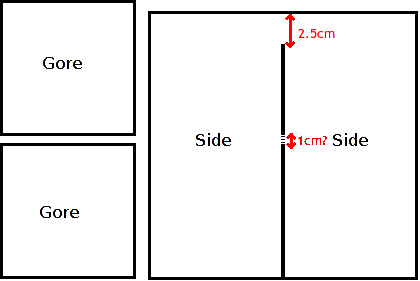
Fig 1: Line drawing of the plausable shape of the pattern pieces used for the hood.
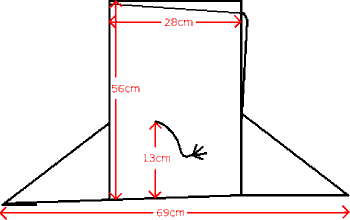
Fig 2: Line drawing of the hood, with dimensions of the original. Not to scale. After Gjessing 1938 and Hügel 2005.
The top of the hood has an angled seam, that is deeper at the front than the back, giving the hood a protrusion on top that looks similar to a cockscomb. This also causes the hood to sit further forward, providing more protection for the face. The top edges, forming the cockscomb, had been turned inward and sewn together with whipstitches in a grey-brown thread from along the top of the hood (Løvlid, 2009: 44). A second seam in a darker brown, beginning near the face-hole ran 3-8 mm below this edge, while a third (seemingly from the same wool as the hoods' warp) is parallel at 10-15 mm from the top (ibid.). Finally, a fourth seam creates the comb at its' final height of 22 to 27 mm (see figure 2) (ibid.). The front and back gores are attached with whipstitching in dark brown wool, which simulaneously tacked the seam allowance to the outside of the hood (Løvlid 2009: 45). The bottom edge of the hood is whip stitched, with neat stitches that run parallel to the grain of the fabric, and there is no evidence that the hem was folded over.
Thicker wool, now brown but originally red and yellow, was possibly meant to be used in a simple embroidery. A red thread is used on the right-hand side of the face opening, running over the top of the hood for 15cm, before being replaced by a yellow thread that continues to the bottom, in whipstitch. These threads were knotted at both the start and end of their paths. A second golden-coloured thread decorates the back seam of the hood, but this 'embroidery' is described as an oblique basting stitch (Løvlid 2009: 46). Although all these seams appear to have been sewn from the outside, that does not necessarily mean these stitches were 'decorative' and in a contrasting thread. The sketch below shows the extent of the 'embroidery' stitches.
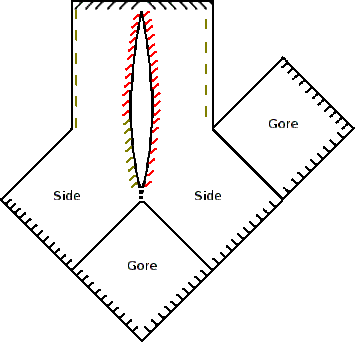
Fig 3: Schematic of where the 'embroidery' stitches are found. Black 'stitches' indicate threads that are not considered to be decorative. Whipstitching along gores not shown. Not to scale. After Hügel 2005 and Løvlid 2009.
Two cords, one on each side of the head below ear-height (13cm from the bottom hem), were sewn on, and were preserved as being tied underneath the chin. The left-hand cord is fully preserved, and 6cm long with a tufted end, that is covered with a little piece of green woven fabric (Løvlid, 2009; 48). It was braided with two pairs of olive-green, and two pairs of red-brown threads in a clockwise spiralling pattern (Løvlid, 2009; 47). See page 48 of Nye tanker om Skjoldehamnfunnet for his braiding diagram.
It was suggested by Gjessing that these strings were designed to close the face-opening (Gjessing 1938; 40-41), while Løvlid has proposed they were tied behind the head in order to widen the face-opening and improve peripheral vision (2009; 159). However, there was no distortion of the fabric where the strings were attached, which implies that the strings were gently or rarely used.
Under tunic
This information primarily comes from Gutorm Gjessings' article, pages 44 to 47. Other sources are referenced in brackets. Help with the Norwegian came from Eva and Maggie.
The under tunic is woolen, and a yellow-brown color in a 2/2 twill. Unlike the hood, it does not appear that different colors were used for the warp and weft. However, the weft threads are thicker, and loosely spun compared to the warp. The garment has been heavily patched, however its' interesting features are still preserved.
The body of the tunic is a single piece of fabric, with no seams over the shoulders, however the fabric was not cut perfectly evenly, so it narrows slightly towards the bottom. Pieced-together gores are inserted into the side seams, with three triangles making one gore. The total width of the left-hand gore is 36cm, while the right-hand gore is closer to 49cm.
The sleeves are not well-preserved, with only the right hand sleeve, and the front of the left remaining. The sleeve appears to only taper at about the elbow. However, because of the patches and repairs to the tunic, it appears Gjessing was unable to determine if the armholes were shaped, or if gussets were inserted under the arms (See line drawings in Gjessing 1938; 38).
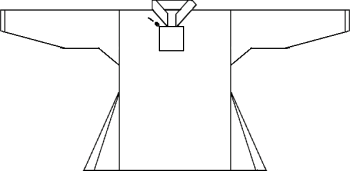
Fig 4: Line drawing of a possible reconstruction of the shirt. Not to scale. After Gjessing 1938.
The most striking feature of the under tunic, is its' standing collar in a 2/1 twill (or, three-shaft twill). Standing collars are style usually seen from the mid 13th century onwards ( Hügel, 2002; 16), but there is a shirt from Guddal, Norway, with a standing collar and an offset neck opening that has been dated to 1035- 1165 CE (Vedeler, 2007) (For clear colour photographs, search for numbers 030993 and 030994 in the Universitetsmuseenes Portal database.) Further afield, there is an example from Turkey, with a late 11th century dating (Dawson, 2006; 53), which also appears to have a similar collar (Dawson, 2003; Dawson, 2006; Beatson, 2008). While these three finds are geographically distant, it may indicate that the idea is not unique to the later Middle Ages.
The collar of the Skjoldehamn tunic is now a maroon color, with paired-together yellow and green vertical stripes every 5cm. This fabric was then sewn to the tunic, with the seam covered with what appears to be a green braided cord. This cord, then runs along the left-hand side of a 14x14cm square flap which covers the keyhole neckline of the shirt. The collar is slightly higher at the back of the neck (5cm high) than at the front of the tunic (4cm).
The same fabric used on the collar, only with the stripes running horizontally, is used on this flap. On the top right-hand corner of the flap, a string threaded with a metallic-silver bead was attached, which may have acted as a button. Diagonal to this edge another cord, now broken, appears to have been sewn onto the shirt to act as a button loop, thereby keeping the flap closed when worn.
It is implied in Løvlid's summary of his upcoming thesis, that this striped fabric is made differently to the bands used to decorate the pants and over tunic of the outfit. While the latter bands are believed to have been woven on a rigid heddle (Løvlid, 2008; 3) it may be that this fabric was woven on a warp-weighted loom. However, this information is likely to become clearer once his thesis has been written.
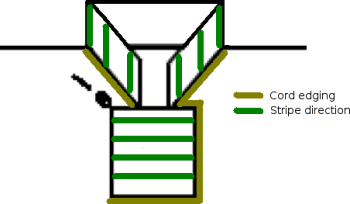
Fig 5: Line drawing of collar and chest. Not to scale. After Gjessing 1938 and Kania 2009.
Overall, the shirt is shorter than the tunic worn over it, falling above the knees, and has been reconstructed as measuring 130cm from wrist to wrist. The width of the main body panel may have been 90cm across, and the hem including gores would have been approximately 180cm around.
Thanks to:
Katrin, Staples, Eva, Maggie, Cathy, Tiff and Ivar from Andøy Historielag!
Resources and References
All webpages checked 23 September 2012.
- Andøy Historielag/ Vesterålen Info “Lang historie i et leikryss” (2009)
http://www.vesteraalen.info/reportasjer_andoy_skjoldeforedrag_07.htm
Includes Photos of the Original Textiles! - Beatson, Peter “A Byzantine Shirt from Manazan Caves, Turkey” (2008)
http://members.ozemail.com.au/~chrisandpeter/manazan_shirt/manazan_instructions.htm - Dawson, Tim “Concerning an unrecognised tunic from Eastern Anatolia” Byzantion 73 (2003) pp.201-210
- Dawson, Tim "Propriety, Practicality and Pleasure: the Parameters of Women's Dress in Byzantium, A.D. 1000-1200" in Lynda Garland [ed] Byzantine women: varieties of experience 800-1200 (Ashgate Publishing, 2006) 41-76
- Gjessing, Gutorm. "Skjoldehamndrakten, en Senmiddelaldersk Nordnorsk Mannsdrakt." Viking, Tidsskrift for Norrøn Arkeologi. 2 (1938) pp.27-81.
https://www.duo.uio.no/handle/10852/37536 - Holck, Per. "Myrfunnet fra Skjoldehamn -- Mannlig Same Eller Norrøn Kvinne?" Viking, Tidsskrift for Norrøn Arkeologi. 51 (1988) pp.109-115.
https://www.duo.uio.no/handle/10852/37611 - Hügel, Vera “paa en Stang Struden efter hannem bære". Forskning på hetter og struthetter fra Nordens middelalder.
Masters Thesis in Archeology, Tromsø University (2005)
http://www.ub.uit.no/munin/handle/10037/100 - Kania, Katrin A Stitch in Time: Skjoldehamn neck flap (2009)
http://www.togs-from-bogs.blogspot.com/2009/01/skjoldehamn-neck-flap.html - Kiel, Julia Die Präsentation samischer Kultur und Geschichte in nordnorwegischen Museen
Masters Thesis in Cultural Studies, Humboldt-Universität Berlin (2003) - Lofotr Viking Museum Skjoldehamndrakten vender tilbake http://www.lofotr.no/Siste_nytt_63.html.
[This webpage no longer exists.] - Løvlid, Dan Halvard Skjoldehamnfunnet i nytt lys (2008) PDF at kaupafar.com
- Løvlid, Dan Halvard Nye tanker om Skjoldehamnfunnet
Masters Thesis in Archeology, Bergen University (2009)
PDF at kaupafar.com - Narmo, Lars Erik (Lofotr Viking Museum) Short about the costume from Skjoldehamn (2009) http://www.vesteraalen.info/reportasje_andoy_skjoldeforedrag_09.htm
Includes Photos of the Latest Reconstruction - Noback, Charles R. “Morphology and Phylogeny of Hair” Annals of the New York Academy of Sciences 53(3) (1951) pp. 476-492
- Nockert, M. and Possnert, G. 2002. "Skjoldehamndräkten" in Att Datera Textiler (Hedemora: Gidlungs förlag) pp. 59-62.
- Olson, Alf Ragnar (2009) "Skjoldedrakten 400 år eldre enn antatt" Andøy Post
http://www.lofotr.no/pdf/Publikasjoner%20fra%20andre/And%F8yposten_om_foredrag_Skjoldehamndrakten.pdf
[This webpage no longer exists.] - Universitetsmuseenes Portal 2012. Online database of items in Norwegian university museums, including Bergen Museum.
https://www.unimus.no/portal - Vedeler, Marianne. 2007. Klaer og formspråk i norsk middelalder (Oslo: Kulturhistorisk museum, Universitetet i Oslo)
https://www.academia.edu/1890814/Kl%C3%A6r_og_formspr%C3%A5k_i_norsk_middelalder [may require academia.edu account]
